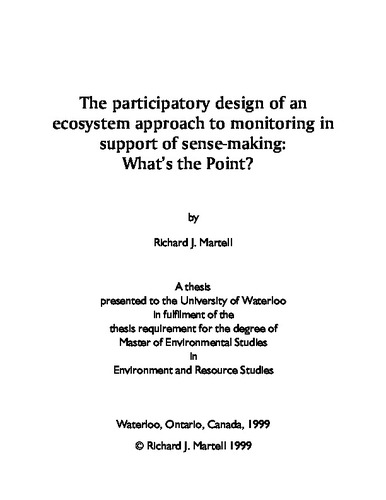| dc.contributor.author | Martell, Richard | en |
| dc.date.accessioned | 2006-08-22 14:08:34 (GMT) | |
| dc.date.available | 2006-08-22 14:08:34 (GMT) | |
| dc.date.issued | 1999 | en |
| dc.date.submitted | 1999 | en |
| dc.identifier.uri | http://hdl.handle.net/10012/1005 | |
| dc.description.abstract | Environmental monitoring initiatives are typically conceived as strictly scientific affairs designed to provide support for managerial decision-making; as a consequence most initiatives are centered on a formal mandate or an overarching mission statement that provides direction for monitoring activity. But official frameworks tend to marginalize lay perspectives as experts pursue disciplinary rigor at the expense of public input, a situation not in keeping with the spirit of the biosphere reserve concept. This thesis argues that an alternative design approach that reaches beyond scientists and resource managers is necessary. Environmental monitoring under an ecosystem approach is subject to scientific, social, and bureaucratic demands that defy easy disentanglement. A medley of factors influence how data are collected, interpreted, and used; neglect of these 'soft' dimensions runs the risk of failing to win the enduring support of stakeholders. There is a need to coordinate activity and to partially align multiple perspectives-this is the 'soft underbelly' of integrated monitoring that gets short shrift in most designs. While there is much monitoring being done in and around the Long Point World Biosphere Reserve, there is little coordination among monitoring groups and no obvious way to combine disparate data sets in a meaningful way. This thesis describes the elements of a locally-sensible framework for monitoring practice that is mainly concerned with trying to make sense of confusing and ambiguous situations; it strives to integrate the 'why', 'what', and 'how' of monitoring in as transparent a manner as possible by crafting 'boundary objects' that help to congeal understanding and provide centers of coordination. Using principles of participatory design in the soft-systems tradition, the overall intent is to primarily support sense-making, not decision-making; to generate searching questions, not final solutions; to facilitate learning, not control. | en |
| dc.format | application/pdf | en |
| dc.format.extent | 1426739 bytes | |
| dc.format.mimetype | application/pdf | |
| dc.language.iso | en | en |
| dc.publisher | University of Waterloo | en |
| dc.rights | Copyright: 1999,
Martell, Richard. All rights reserved. | en |
| dc.subject | Environmental Studies | en |
| dc.subject | Environmental | en |
| dc.subject | monitoring | en |
| dc.subject | Ecosystem | en |
| dc.subject | management-Citizen | en |
| dc.subject | participation | en |
| dc.subject | Biosphere | en |
| dc.subject | reserves | en |
| dc.subject | Social | en |
| dc.subject | learning | en |
| dc.subject | Information | en |
| dc.subject | technology-Social | en |
| dc.subject | aspects | en |
| dc.title | The participatory design of an ecosystem approach to monitoring in support of sense-making: What's the Point? | en |
| dc.type | Master Thesis | en |
| dc.pending | false | en |
| uws-etd.degree.department | Environment and Resource Studies | en |
| uws-etd.degree | Master of Environmental Studies | en |
| uws.typeOfResource | Text | en |
| uws.peerReviewStatus | Unreviewed | en |
| uws.scholarLevel | Graduate | en |

